This article first appeared on January 2001 issue of the Horological Journal.
It is available in pdf format for off-line reading and printing.
Click on this link to download the compressed file (1.1 MB)
Renato and Franco Zamberlan describe the history of this famous clock prior to its recent controversial restoration.
The famous clock over looking St Mark's Square in Venice is possibly the second most well known clock in the world; after "Big Ben". Its remarkable reputation comes not only from its aesthetic appeal, but also from its age and very prominent location in a popular tourist venue.
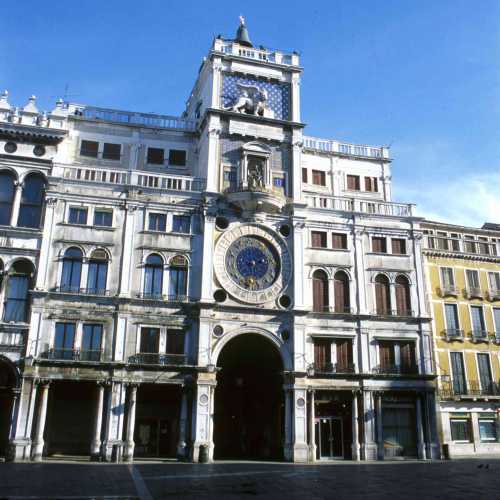
The Original Clock, 1493
The clock has its origins in 1493 when the Venetian Republic commissioned Gian Carlo Rainieri, a clockmaker from Reggio Emilia, to make the movement. His father, Gian Paolo, had established a reputation for the construction of a clock in their hometown in 1481.
When the movement was commissioned there was not yet a place to put it. Three years later, some buildings (part of the Procuratia de Supra in St Mark's Place) were demolished and the construction of the clock tower began. Gian Paolo Rainieri was called to Venice with the clock mechanism, to ensure that the work was carried out correctly to enable it to be accommodated; an early example of technical cooperation.
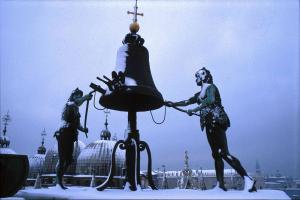
The Moors, which strike the hours, in a wintertime Venice capped with snow. Click to enlarge.
In December 1497 the great bell (5ft high and 4ft in diameter) was completed by Simone Campanato and was put on the top of the tower, together with the two bronze giants (8.5ft high) that strike it with hammers.
These actually represent two shepherds but later carne to be called "Moors" because of their patina.
A smaller bell was struck before the main one, warning people to count the number of hours sounded by the great bell.
The Doge Agostino Barbarigo inaugurated the Clock on February 1st 1499. His statue was placed near the Lion, which is the symbol of the town, on the upper part of the Tower facade, but was destroyed in 1797 at the end of the Venetian Republic.
The clock was weight driven and regulated by a foliot. Not much is known about the movement itself.
An interesting feature was the Magi's carousel; the three Kings, preceded by an Angel blowing a trumpet, passed in front of the gilded bronze Madonna with Child. It should be noted that the trumpet actually emitted a sound, this was achieved by a bellows and a type of organ pipe (now lost). Today the wooden statues of the Magi and the Angel are no longer the originals but are quite faithful replicas of those in 1499.
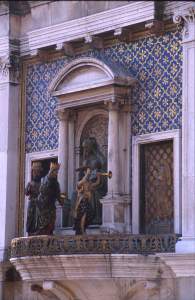
The procession of the Magi, which takes place hourly only on 15 days per year. The mechanism was completed in 1759. Click to enlarge.
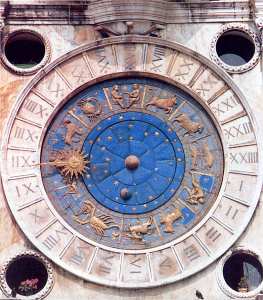
The dial with its original 24hr markings rediscovered in 1896. Click to enlarge.
The most outstanding characteristic of the mechanism were undoubtedly the astronomical indications. On the large dial (15ft diameter), the relative positions of five planets: Saturn, Jupiter, Mars, Venus and Mercury could be read on concentric circles, together with lunar phases and the position of the Sun in the zodiac; according to the Ptolemaic system.
Last but not least, the 24-hour indication used the Italian system, with hours of different lengths between summer and winter. A much simpler dial was placed on the reverse of the Tower towards the Mercerie.
Four windows around the main dial were used to display some orreries. Unfortunately no descriptions of them survive.
People were amazed by all this complexity and the clock represented the cultural and economic heritage of Venice in one of its most flourishing periods. It is located so as to be clearly visible to those arriving by sea. This was surely intentional when its position was chosen.
At this point (1499), the Venetian Government decided to allow Gian Carlo Rainieri and his family to live in the Clock Tower and to pay him a fee to maintain the complex movement in good running order. This began a long-lasting tradition which continued until 1998; a "temperatore" was always present in the building.
In 1506 two wings were added at the sides of the Tower, probably the better to merge into St Mark's Place. The procession of the Magi, which takes place hourly only on 15 days per year. The mechanism was completed in 1759.
Gian Carlo Rainieri died in 1517 and until 1750 the clock was maintained by various temperatori with different levels of skill. 250 years after its construction, the mechanism was in pretty bad condition; the astronomical indications and the Magi carousel no longer worked.
In the meantime, further work on the building was carried out. The last stages of the Tower wings were added, with the top floor stepped back to provide a terraced balcony. Eight columns were placed near the main pillars, to reinforce the whole structure. Some decorative items were modified bringing the construction almost exactly to its present shape.
The New Clock of 1755
In 1752 Bartolomeo Ferracina, the most renowned clockmaker of the time, was chosen for the work on the mechanism. In 1755 the new Magi and Angel were completed; these figures are those still seen today. He actually made a completely new movement. The old mechanism and the original astronomical dial were given to him in part payment. The new movement, although modified, remains until the present day. It has four trains, in a peculiar cruciform pattern, one for the time, two for the hour strike by the Moors and one for the special 132-blow strike mechanism which will be described later. On the upper floor of the tower, above the main movement, there is a separate mechanism for the Magi's carousel.
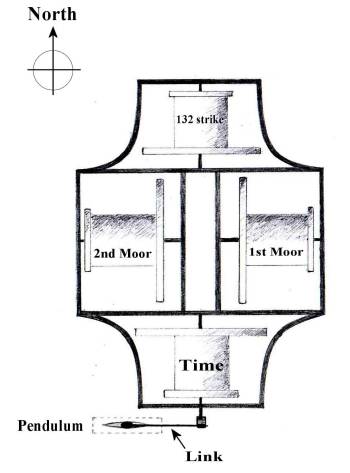
Schematic drawing of the movement of 1 755 showing the pious Cruciform layout of the trains.
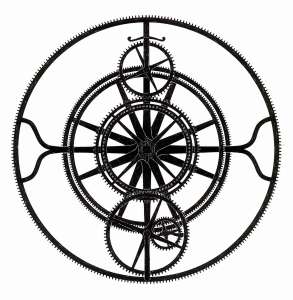
The lunar and zodiac mechanism underlying the main dial (drawing by A. Peratoner). Click to enlarge.
The changes reflected the innovations introduced in horology during the previous 250 years; a Graham 'deadbeat' escapement was adopted together with a 1828bph (1.97s) pendulum; quite a long and unusual one. The astronomical dial was heavily simplified, 4; only the indications of lunar phases and zodiac signs remained, everything referring to the other planets was eliminated.
The new striking system was based on the by then almost universally accepted 12-hour system, instead of the old 24-hours method. The other dial rim was modified accordingly with two series of Arabic numbers from 1 to 12 instead of the original single sequence of roman numerals from I to XXIV.
Before midday and midnight, a pair of hammers, placed on the opposite side of the Moors, struck six groups of 22 blows (for a total of 132) on the great bell. These represented the whole of blows struck by the giants during the preceding 11 hours (1+2+3+.. .+11 multiplied by 2, the number of the Moors). An entire train of the mechanism was devoted to this function.
The work was completed in 1757 but the Magi's carousel had still to be repaired. Ferracina completed it in 1759 and it was decided to show the procession only on 15 days a year; during the special Venetian festivals surrounding Ascension day. This habit survives until the present time.
In 1797 the Venetian Republic ended, and in 1807 the Tower came under the control of the Venetian municipality instead of St Mark's Basilica authority.
Modifications in 1857
More repair work was required in the middle of the 19th Century, both to the building and to the mechanism. In 1856 the temperatore Giovanni Doria, together with Annibale Marini (a clock technician), described the state of the movement and the necessary repairs in one of the few technical briefs regarding this famous clock. A committee formed by the municipality chose Luigi De Lucia for this task in 1857.
He was also asked to introduce a luminous display that could show time during the night hours. This idea had been suggested in 1824 but had not been achieved. Two large panelled wheels (called tàmbure) were made, 5. They carried twelve pierced metal sheets covered by glass, indicating hours using roman numerals and the minutes, at five- minute intervals, with Arabic figures. A gas lamp (later converted to electricity) was placed behind the pierced panels so that the indications were clearly visible, 6. A new small train was added on the top of the main mechanism (see 10) to move the panelled wheels. This made St. Mark's one of the first tower clocks in the world to display time in a digital format.
The tàmbure were exposed through the doors used by the Angel and the Magi during their parade.
>
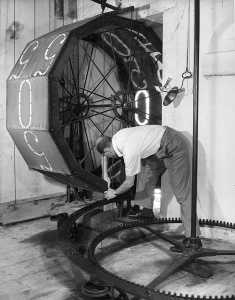
Panelled wheels forming the digital display of 1857, viewed from inside the tower. Click to enlarge.
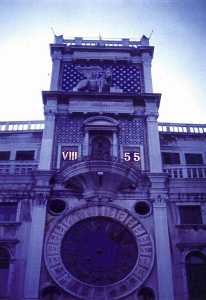
The panelled wheels viewed at night. The openings in which they are displayed are also used for the procession of the Magi, when the digital display is lifted out of the way. Click to enlarge.
This would seem to eliminate the procession, but De Lucia found a way to lift the great panelled wheels to allow the procession during Ascension. During this period the digital time indication was replaced by a manual system. The temperatore simply had to expose some painted panels in the round windows beside the main dial, 9, to show current time. As these had to be changed every five minutes this was a busy time for the incumbent!
De Lucia also modified the escapement. The Graham deadbeat was replaced with a pinwheel, 7, and the pendulum was slightly lengthened, from 1828 to 1800 bph, a neat 2 seconds, and there were minor improvements to the suspension and time regulating systems. It is interesting to note that the pendulum is not placed directly in front of the escapement, the wooden rod would interfere with the protruding arbor which carries the motion to the main dial. The pendulum rod was connected to the escapement by a horizontal link, as is common on Morbier clocks. This geometry had been established by Ferracina in 1757 and is recorded in a drawing made by Nicolo Erizzo in 1856.
Many other minor repairs were carried out, such as rebushing pivot holes.
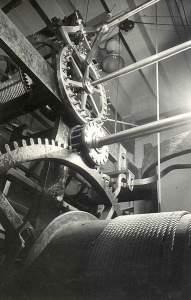
The pinwheel escapement fitted in 1857. Click to enlarge.
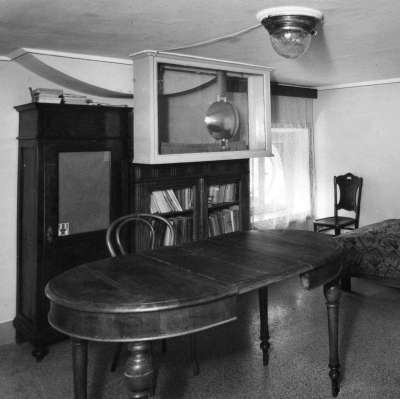
Pendulum bob of 1857 inside a glazed box in the room below.
The pendulum rod being more than 13ft long, a hole going through to the room below had been required since the middle of 18th Century, when Bartolomeo Ferracina introduced the deadbeat escapement.
This picture shows the bob oscillating inside a glazed box on the first floor of the Tower, below the movement. It was taken around 1950.
The clock was reactivated on June 2nd, 1859 but by 1866 the Magi mechanism, the secondary dial work and the great panelled wheels required further intervention.
In 1896 there was an important change from an aesthetic point of view. The old outer rim of the dial, carrying roman numerals from I to XXIV, 9. was rediscovered. It was under the Arabic figures applied over it during Ferracina's work.
At the beginning of World War I, the 132-blow strike was disabled, because of the curfew, and due to the high noise it produced, especially at midnight. It was never reactivated.
General Overhaul, 1950s
We are almost at present times. In 1951, when Giovanni Peratoner, who had followed his father (and following WW2, his mother) as temperatore, started a general overhaul of the movement. He had to shift the pendulum to a higher point of suspension, because of a slight movement in the Tower building. As a result the bob no longer reached to the room below. The worn suspension was replaced with a new part: still of knife-edge type, and the pallets were repaired.
By 1953 the clock was again running in good order and in 1963 it was decided to allow the Magi's carousel on 6th January (Epiphany), in addition to the Ascension period.
In 1997 the clock was completely dismantled to enable important restoration work on the tower. This provided an opportunity for the
current restoration sponsored by Piaget.
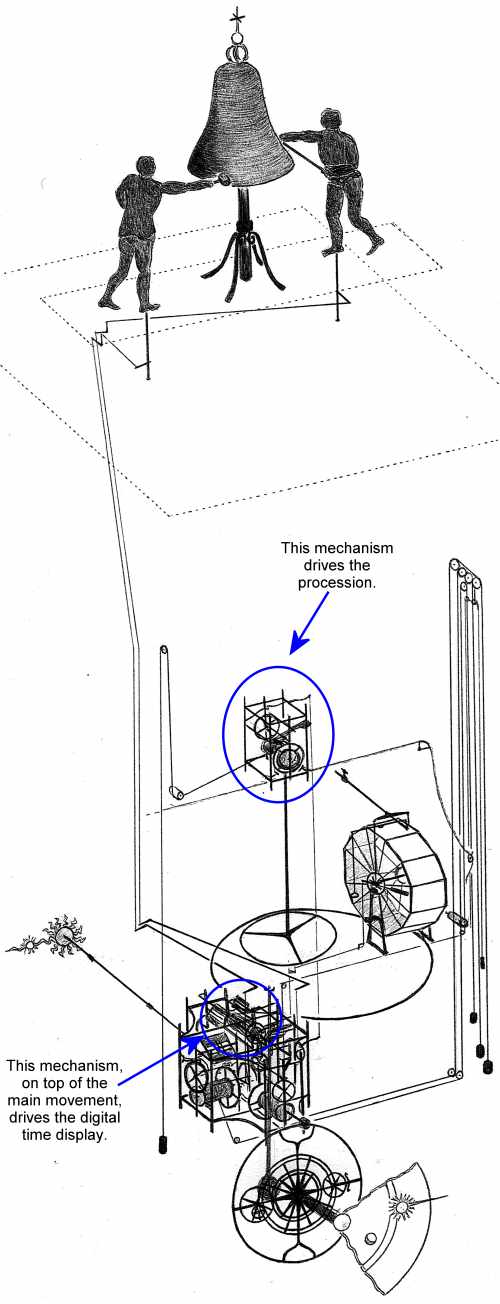
Sketch of the mechanism drawn by A. Peratoner.
Acknowledgement
We wish to thank Alberto Peratoner, the last Clock temperatore, for his help in the preparation of this article.



